 |
Beyond Courage: The Untold Story of Jewish Resistance During the Holocaust In this comprehensive book about Jewish resistance across eleven countries, Rapport sets out to debunk the myth that “Jews went like lambs to slaughter” during WWII. She succeeds, writing one of the most fascinating nonfiction textbooks that is both difficult and hopeful. Approaching the subject in a straightforward manner, she highlights the defiance of tens of thousands of Jews. Each of the five sections begins with a poignant poem written by an adolescent, followed by a brief historical piece that sets up the context. Rappaport profiles over twenty Jewish resisters–each a riveting story of defiance in the face of unimaginable circumstances. Part One: The Realization covers the period when Hitler assumes power from 1933-1938. Sixteen-year-old Ernst recalls a school day that started like any other, only this time his teacher arrived late and immediately sent his students home. Stunned to see his synagogue burning from the windows of the train, Ernst ignores his teachers’ warning and gets off the train in an attempt to rescue the sacred Torah scrolls. Part Two: Saving The Future reveals untold stories of parents trying to smuggle their children to safety. After hiding their own son Paul with friends, Hertz and Hava Jospa of Belgium assume the Germanic names of Joseph and Yvonne and set out to create the CDJ, the Jewish Defense Committee, as a secret network of Christian families and institutions providing shelter for Jewish children. Parts three through five capture the spirit of partisan and other underground Jewish groups in ghettos, camps, and in the forests in order to survive and save lives at all costs. Included are maps, diagrams, photos, reproductions, a timeline of important events, and an extensive bibliography. This book is an essential textbook for any middle school or high school curriculum. 2012, Candlewick Press, Ages 10 up, $22.99. REVIEWER: Avee Gee (Children’s Literature). ISBN: 9780763629762 |
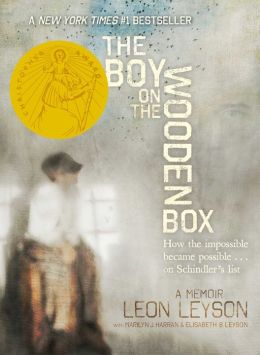 |
The Boy on the Wooden Box: How the Impossible Became Possible . . . on Schlindler’s List The Boy On The Wooden Box is the memoir of a young boy on Schindler’s List. This list allowed a unique fate for him and his family. The sincerity and raw emotion detail not only a miserable time in history but also the bravado of several individuals as they risk death or torture to do what is right. The boy’s memories of standing on a box to work in the factory are meticulously written and depict his life during this time–they are memories of perseverance, bravery, and innocence. Leyson brings readers to tears while leading them to empathy for the people of this devastating time in history. Through his words readers can experience life through an innocent child’s eyes. Much like The Boy With The Striped Pajamas (David Fickling, 2006/Voya December 2006) or The Book Thief (Knopf, 2006/Voya June 2006), this title brings to readers a story of bravery and the fight for a chance to live. Perhaps history forgets the children among all the wars and travesty throughout history, but this book does not allow readers to forget. They will be exposed to simple and sensitive accounts; young adult readers will relate to this historical piece of literature. This is a must-read. VOYA CODES: 5Q 4P M J S (Hard to imagine it being any better written). 2013, Atheneum/Simon & Schuster, Ages 11 to 18, $16.99. REVIEWER: Mirta Espinola (VOYA). ISBN: 9781442497818 |
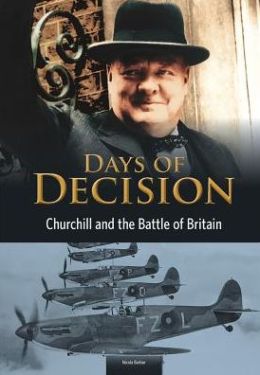 |
Churchill and the Battle of Britain Political leaders often face harsh criticism for their decisions during any kind of crisis, but most people are unaware of all the factors that must go into the decision. During the years leading up to the attempted Nazi invasion of Britain, Winston Churchill often sounded a voice of caution about the German government’s disregard for treaties that were signed in the aftermath of the First World War and about the ineffectual response of the countries whose borders were threatened by that disregard. Despite opposition from members of his own government, Mr. Churchill was able to convince the military leaders that building up the country’s air power was crucial to defending their island. He made an excruciating decision to destroy part of the French navy rather than allow the ships to be commandeered by the Germans, a decision that caused him anguish but that proved to be fortuitous. His leadership and oratory skill is now recognized as an important factor in Britain’s ability to withstand the assault from Hitler’s forces during what has become known as the Battle of Britain. Part of the “Days of Decision” series, this readable and well-researched volume would be a great addition to a classroom library or school library. There are numerous photographs throughout the book, a fairly comprehensive bibliography, a nice index, and a glossary. For middle school or high school readers, the title could be used in both history and political science classes. Very highly recommended. 2014, Heinemann/Capstone, Ages 11 to 16, $35.00. REVIEWER: Ellen Welty (Children’s Literature). ISBN: 9781432976347 |
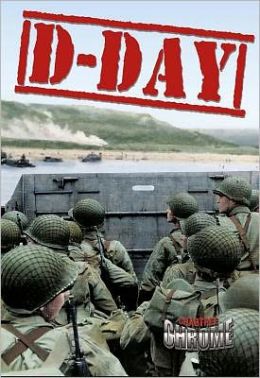 |
D-Day Although the Allies established a strong foothold in Europe on D-Day, the war was far from over. Despite the months the war continued to battle on, the importance of D-Day cannot be denied. In this very brief overview of D-Day, Martin manages to convey the importance of the invasion as well as the logistical details that made D-Day an overall success. The author begins with a brief summary of the events leading up to D-Day, beginning with brief definitions of the Axis and Allied powers and continuing with the planning that put the operation into action. Each assault is given a brief summary, including the paratroopers who landed hours before the land invasion and helped to secure a safe foothold for the troops landing later. Illustrations throughout the text add depth to this brief look at D-Day and provide invaluable insight into the entire operation. The text is an appropriate introduction to D-Day but cannot be considered anything more than a very brief introduction to D-Day. 2013, Crabtree Publishing Company, Ages 10 to 14, $9.95. REVIEWER: Danielle Williams (Children’s Literature). ISBN: 9780778779247 |
 |
D-Day: The Allies Strike Back During World War II Students of World War II often debate the turning point of the war. Some experts point toward the German defeat at Stalingrad as the beginning of the end for the Nazi Reich. Other scholars note that the Battle of Midway, which resulted in the devastation of the Japanese aircraft carrier fleet, was an engagement that changed the outcome of the war. For many writers, the Allied landing at Normandy on June 6, 1944 remains the pivotal moment in the entire war. In this chapter of the illustrated “24/7 Goes to War” series, younger readers are given a wonderful opportunity to understand what it might have been like to participate in the D-Day invasion. Through the words and descriptions of actual veterans at the landing, author Terry Miller presents an overview of the invasion with human interest. Readers will encounter the words of Allied soldiers who saw their comrades gunned down before they could even get out of their landing craft. Other veterans describe what it was like to face the seemingly insurmountable odds against survival on Omaha Beach. Through these accounts of the experiences on the Normandy beaches, readers come as close as they can to realizing the human costs involved in historical events. In this way, this book represents the type of historical writing that will draw readers into the world of the past rather than repel them through an arid approach to a potentially vibrant story. 2010, Scholastic Inc, Ages 10 to 14, $27.00. REVIEWER: Greg M. Romaneck (Children’s Literature). ISBN: 9780531255278 |
 |
Franklin and Winston: A Christmas That Changed the World Wood (No One But You) pulls back the curtain on history to offer a snapshot of Winston Churchill’s Christmas 1941 visit to the Roosevelt White House. The mix of famous quotes, humanizing anecdotes, and references to both monumental work (war strategizing) and holiday fun imbue this volume with an inviting fly-on-the-wall tone. Moser (Oh, Harry!), too, effectively balances light and serious with his watercolor portraits, which were often inspired by archival photos. Ages 6-10. 2011, Candlewick Press, Ages 8 to 10, $16.99. REVIEWER: Publishers Weekly (Publishers Weekly). ISBN: 9780763633837 |
 |
Irena Sendler and the Children of the Warsaw Ghetto She was a little woman, less than five feet tall, but if height were measured by courage, heart and spirit, she would be a giant. Sendler, a young Catholic social worker, did her best to tend to the wounded and bring bread to the hungry; but as soon as Poland surrendered to Germany, she joined Zegota, a resistance movement that helped rescue Jews. Infiltrating the ghetto disguised as a nurse, she saw starvation and sickness, and as the Nazis began to empty the ghetto, she began to smuggle out the children. Her story is told in an oversized illustrated book, a column of generous-sized black text against a white background placed adjacent to the dark, doom-laden paintings. The few hopeful images have a lighter background — for instance as Sendler gently teaches a little Jewish girl her new name and the Catholic prayers she must learn to save her life; and also when Sendler buries the jars containing the assumed Polish and Jewish names of the children under a tree in a friend’s yard, looking forward to the future–when the names will be turned over to a Jewish Zionist organization. Only an artist as fine as Farnsworth could manage to represent the damage and doom of the ghetto, the horror of the Nazis seizing Sendler, and the Warsaw Uprising; and only an author as talented and knowledgeable as Rubin could tell a story like this in a way that will be understood by children from grades 4-6, without diminishing its impact. Irena’s story remained untold for many years, because the Soviets who took over Poland regarded her as a traitor since Zagota was supported by the anti-communist Polish government in exile. Sendler says that she was taught by her father that when someone is drowning, you don’t ask if they can swim, you just jump in and help. The author has a distinguished history of writing children’s picture story books about the Holocaust, among them: Fireflies in the Dark: The Story of Friedl Dicker-Brandeis and the Children of Terezin; The Cat with the Yellow Star: Coming of Age in Terezin (with Ela Weissberger); The Anne Frank Case: Simon Wiesenthal’s Search for the Truth; and The Flag with Fifty-six Stars: A Gift from the Survivors of Mauthausen. Ostensibly for ages 6-10, books of this type are best used with children from 9-11 and may also serve as an entry point for older students. Bill Farnsworth has worked with Goldman on The Flag with Fifty-six Stars, and with David A. Adler on A Hero and the Holocaust: The Story of Janusz Korczak and His Children. Holiday House, Ages 9 to 12, $18.95. REVIEWER: Marcia W. Posner (Association of Jewish Libraries Reviews). ISBN: 9780823422517 |
 |
Irena’s Jar of Secrets Irena Sendler, a Catholic social worker and all-but-forgotten rescuer of over 2,500 Jewish children from the Warsaw Ghetto, is the subject of Marcia Vaughan’s engaging book. Vaughan introduces us to Sendler as a child, follows her through the Holocaust and its aftermath, and then to an excerpt of a letter she wrote the Polish Senate a year before her death in 2008. It is not a quick class read-through. The story, inspiring without whitewashing the events, fairly provokes student discussion on a particularly higher-order of questioning: “What did her father mean that you should rescue a drowning person even if you can’t swim?” or “How did Irena convince parents to give up their children?” or “How did she think so quickly during her rescues? What would you have done?” Ron Mazellan’s dark, off-focus illustrations lend a soft, depressed mood; the only shining, sharp object in the 32 pages is a Nazi helmet, which elicits another exchange of ideas. His portrayal of Irena clutching her father’s hand beside his typhus death bed is troubling and ultimately inaccurate. According to Jack Mayer’s account in his Life in a Jar, The Irena Sendler Project (Long Trail Press, 2011), Dr. Sendler refused to let anyone closer than the hallway. The role of typhus in Irena’s life, first as the cause of her father’s death, and then as her entree into the Ghetto as a nurse, bring about questions of destiny. Irena’s unrelenting modesty about her actions, even more. While Vaughan covers much the same ground as Susan Goldman Rubin does in her Irena Sendler and the Children of the Warsaw Ghetto (Holiday House, 2011), Vaughan’s simpler and more drama-filled text seems better suited for younger readers. Vaughan’s afterword and author’s sources give curious readers a surfeit of new paths to follow on their journey to learn more. A strongly student-recommended volume. 2011, Lew and Low Books, Ages 9 to 13, $18.95. REVIEWER: Charna Gross (Association of Jewish Libraries Reviews). ISBN: 9781600604393 |
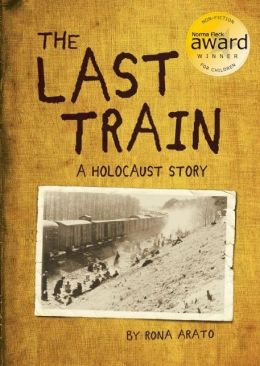 |
The Last Train: A Holocaust Story The hardest decision to make, when introducing children to the history of the Holocaust, is when a child is old enough to understand the horrors that were perpetrated. Most young people become familiar with the events around age twelve through Anne Frank’s writings or Lois Lowry’s. Number the Stars. Arato, in the fictionalized account of her husband’s life experience, has brought the actual experience of the concentration camp to a slightly younger audience. Arato’s husband, Paul, was rounded up from his Hungarian village in the days before D-Day, therefore his time in captivity was shorter than some prisoners. He was also part of a somewhat “privileged” group of prisoners who were designated by Adolf Eichmann to be held in case they were needed for a prisoner exchange. Despite these factors, Paul and his family were transported as slave labor to work on a farm and, ultimately, transferred to Bergen Belsen in the last days of the war. Paul’s treatment was inhumane but survivable. He was able to remain with his ailing mother and brother and even make contact with his uncle in another part of the camp. Arato touches on Paul’s encounters with stacks of dead prisoners and a child being shot to death for the “crime” of having a happy birthday. These horrors are touched on, but not lingered upon. The conclusion, in which a grown-up Paul meets his liberators and, after years of silence, tells his story is an emotionally moving conclusion. Honestly, this is the best true chapter book I have read on the Holocaust in quite some time. The fictionalization places enough distance between the young reader and the truth to make it palatable, yet the facts are undeniably present for discussion. With witnesses dying every day, every documentary such as this is critical. 2013, Owl Kids, Ages 9 to 14, $15.95. REVIEWER: Lois Rubin Gross (Children’s Literature). ISBN: 9781926973623 |
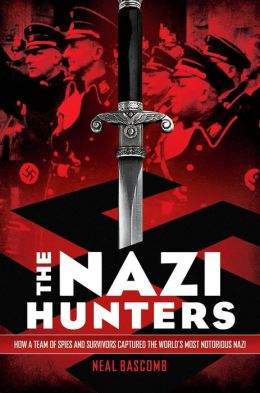 |
The Nazi Hunters: How a Team of Spies and Survivors Captured the World’s Most Notorious Nazi Adapting his 2009 book, Hunting Eichmann, Bascomb makes accessible to teens the story of tracking and bringing to justice Adolf Eichmann, the Nazi war criminal. The cast–Germans, secret Israeli operatives, Jewish volunteers, El Al airline employees, and Eichmann’s family–is huge, though made easier to track with a list at the beginning. Bascomb tells the story as the spy thriller it is, with constant switches from Eichmann’s life to his pursuers, as he flees the approaching Allies and then Germany. Ending up in a poor district of Buenos Aires, Eichmann had sent for his wife and four sons. Each day he plodded to his job at a Mercedes factory, a far cry from his former life as a Nazi officer in charge of transporting Jews from their homes to death camps. His cover is blown when his oldest son’s girlfriend invites the son to dinner and her Jewish father becomes suspicious. From then on, suspense builds as Eichmann is tracked, captured, flown to Israel, and finally tried for his crimes and executed in 1962. Bascomb stresses the agents’ surprise that Eichmann lived such a desultory life and appeared so resigned to obeying their orders. The author believes that the major effect of the trial, testimony of witnesses, and Eichmann’s denial of guilt was not Hannah Arendt’s concept of the “banality of evil,” but the opening it gave for Holocaust survivors to tell their painful stories to the world. Many formerly reluctant countries were then moved to pursue war criminals and bring them to justice. Well-researched and provided with notes, Bascomb’s account, with its black-and-white period photos, will help teens understand World War II and the Holocaust, and may inspire further research about the war’s atrocities, intelligence agencies, and the emergence of the state of Israel. 2013, Arthur A. Levine/Scholastic, Ages 12 up, $16.99. REVIEWER: Barbara L. Talcroft (Children’s Literature). ISBN: 9780545430999 |
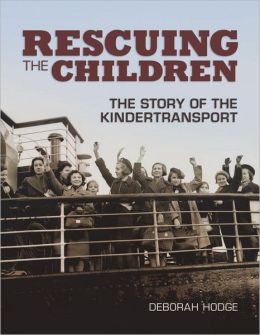 |
Rescuing the Children: The Story of the Kindertransport Almost ten thousand children travelled from Germany, Czechoslovakia, Austria, and Poland to the safety of England between December 1938 and September 1939, right before the start of WWII. This book brings the story of the Kindertransport alive for elementary and middle school students. Readers meet eight children who were passengers on the Kindertransport and get to know them through anecdotes in their own words and photos of them as children. The author emphasizes that what makes this story remarkable is not only how brave the children were as they travelled away from their families and homes, but also how brave their parents were to send them away and how brave the organizers of the Kindertransports were as they risked their own lives to save the children. During a time of great sadness, these individuals had hope for a better future. Rescuing The Children tells an extraordinary story with the addition of primary source material, which could be used in the classroom to enhance understanding of what children experienced as passengers on the Kindertransport. This book is enhanced by the inclusion of up-to-date information on the children featured, maps, a timeline, a list of related books, and an index. VOYA CODES: 5Q 3P M J (Hard to imagine it being any better written; Will appeal with pushing; Middle School, defined as grades 6 to 8; Junior High, defined as grades 7 to 9). 2012, Tundra, 64p.; Index. Timeline. Further resources. Maps $17.95. Ages 11 to 15. REVIEWER: Amy Wyckoff (VOYA). ISBN: 9781770492561 |
 |
Weapons, Gear, and Uniforms of World War II In this chapter in the “Equipped for Battle” series readers are given a look back in time to the material objects of World War II. The Second World War represents the single most violent event in human history. In a war that touched virtually every continent, the combined human cost of battles, campaigns, bombing, and genocidal practices left over fifty million people dead. Because of this terrible toll of war, World War II continues to interest students young and old with any fascination for military history. Among those with a bent for military studies there are many students with a particular interest in the material objects of war. In this particular book readers are given a look back at the armored fighting vehicles, automatic weapons, combat aircraft, uniforms, and grenades that were part and parcel of the Second World War. As with other books in this series, this particular publication combines concise text with numerous photographs to map out the ordnance of war that were the tools of soldiers during World War II. In this way author Burgan provides a serviceable vehicle for younger readers to look back in time and study the weapons, armaments, and uniforms typical of the fighting men of the Second World War. 2012, Capstone Press, Ages 8 to 11, $27.32. REVIEWER: Greg M. Romaneck (Children’s Literature). ISBN: 9781429676502 |
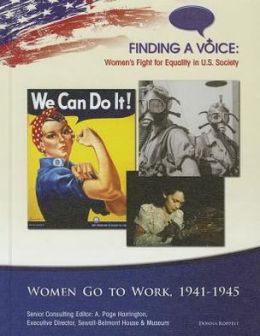 |
Women Go to Work, 1941 – 1945 Meet Rosie the Riveter, Wanda the Welder and millions of other women who answered the call from the U.S. government to take factory jobs during the Second World War. As a group, these women became known as “Rosies.” A fascinating and comprehensive look at how the war changed the world and the women in our country. Stories and interviews with famous and anonymous women are highlighted throughout the book. Women who kept U.S. factories running during the war, who stayed home trying to keep the farm going and women who followed men into service by forming the WACs, the WAVEs and other female groups formed to help win the war. Over thirty photos and illustrated posters in color and black and white are found throughout the six chapters. Bolded blue text boxes titled Fast Facts draw the reader’s attention to information. Part of the “Finding A Voice: Women’s Fight for Equality in U.S. Society ” series, other titles include Fight for Equality in U.S. Society; Woman’s Place in Early America; Origins of the Women’s Rights Movement; Seeking the Right to Vote; Women’s Rights on the Frontier; The Equal Rights Amendment; Women in the Civil Rights Movement; The Women’s Liberation Movement, 1960-1990 and The Feminist Movement Today. In addition to a Table of Contents, readers will find Chapter Notes, Chronology, Further Reading Resources, Internet Resources, Glossary and Index. The 1939 to 1945 Chronology is enlightening in facts shared including rationing of food and shoes. Highly recommended for school libraries and for studies relating to twentieth century societal issues, unemployment, economic conditions, women and history. An opportunity for current and future generations to read the untold stories documenting the efforts by women and men of all races, religions and backgrounds to win equality for women under the law. A very welcomed book. 2013, MasonCrest/National Highlights, Ages 11 to 14, $22.95. REVIEWER: Suzanne Javid (Children’s Literature). ISBN: 9781422223574 |
 |
Women Heroes of World War II: 26 Stories of Espionage, Sabotage, Resistance, and Rescue Inspiring tales of women who risked their lives to fight the Nazis and shelter Jewish refugees are brilliantly told in this excellent volume. Young readers will be awed as they learn about the brave women who could not turn away from the injustices around them. Not all survived the war; some were tortured and killed and some were thrown into death camps, but escaped or were liberated at the end of the war. Many of the women featured led ordinary lives as students, workers, wives and mothers, but they acted as couriers and spies and harbored those fellow citizens that were being hunted down by the Nazis. They hailed from Germany, France, Great Britain, the US, Poland and many other countries. The profiles of each woman are collected into chapters designating which country she served. At the end of each profile is a list of resources to consult for additional information. Engaging and well written, the book is also well researched and a logical choice for middle and high school history classes, projects and papers. A comprehensive glossary, notes, and bibliography are included. 2011, Chicago Review Press, Ages 12 up, $19.95. REVIEWER: Jeanne K. Pettenati, J.D. (Children’s Literature). ISBN: 9781556529610 |
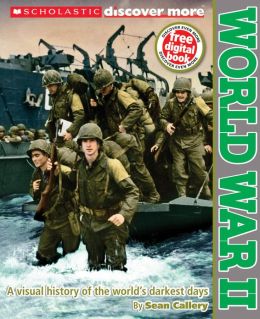 |
World War II World War Two remains the deadliest conflict in human history. By recent estimates over sixty million human beings lost their lives in a war that touched nearly every part of the globe. In Europe, the Nazi war machine constructed under the twisted leadership of Adolf Hitler was eventually smashed to pieces. In the Pacific Theater of Operations, the militaristic forces of Imperial Japan surged to early victories only to ultimately experience utter defeat at the hands of the Allied Powers. World War Two inflicted suffering not only on frontline soldiers but also on the civilian populations of the warring nations. In fact, unlike most prior wars, it was the civilians that bore the brunt of suffering as total war strategies focused destructive attention on the various home fronts. In this visual history of that destructive war, Author Callery combines a wealth of information into a densely illustrated format. Using historical time lines, themed segments of text, and a potpourri approach to facts this publication will appeal to readers with any sort of interest in the topic. Of particular interest are the creative visual approaches that show how a German submarine was constructed or the inner workings of a tank. In addition, the periodic insert of eyewitness accounts augment the storyline and help readers to see what actual participants experienced in the war years. While this is a supplementary text not intended to be a comprehensive review of critical events and leaders during World War Two, it does provide valuable information to readers. 2013, Scholastic, Ages 10 up, $15.99. REVIEWER: Greg M. Romaneck (Children’s Literature). ISBN: 9780545479752 |
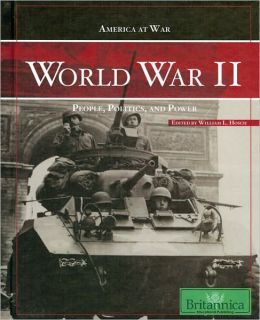 |
World War II: People, Politics, and Power This five-volume America at War set provides useful information for students who are preparing a research project or are simply interested in the battles, political and military figures, and background information presented. Each volume is well organized, with a liberal sprinkling of photographs, short biographical sketches, and primary source documents. In the World War II volume, prominent figures, including Hitler, Stalin, Roosevelt, Churchill, are profiled, as well as important strategies and battles. Minor editing errors–such as a date discrepancy for the organization and attack at the Battle of the Bulge on pages 14 and 151–are noted, but the majority of the text is accurate and engaging. Other titles in the series include The American Revolutionary War and the War of 1812, edited by Jeff Wallenfeldt, The American Civil War and Reconstruction also edited by Jeff Wallenfeldt, The Korean War and the Vietnam War, edited by William L. Hosch, and World War I, edited by William L. Hoschand. While not all inclusive or fully comprehensive, this well-prepared series will be of value to readers for both classroom assignments and personal interest. (America at War) VOYA CODES: 4Q 3P M J S (Better than most, marred only by occasional lapses; Will appeal with pushing; Middle School, defined as grades 6 to 8; Junior High, defined as grades 7 to 9; Senior High, defined as grades 10 to 12). 2010, Britannica, Ages 11 to 18, $49.00. REVIEWER: Donna Miller (VOYA). ISBN: 9781615300082 |
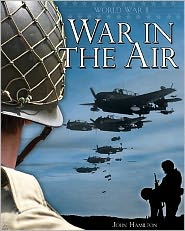 |
War in the Air World War II was fought in theaters across the globe. One of those theaters was in the air as Allied airmen fought against Japanese and German foes. During World War II, bombers fought their way into enemy territory and devastated cities. Ground support aircraft such as the German Stuka spread terror in ground troops and smashed tanks. Fighter aircraft such as the Spitfire, Messerschmitt, Mustang, and Zero not only played a major role in the air war but also became legendary in their own right. By the end of the war cities lay in ruins, thousands of planes had been shot down, and tens of thousands of airmen had perished all as part of a concerted effort to control the skies. In this illustrated work readers are provided snapshot chapters of the individual aircraft, campaigns, and strategies that made up this important aspect of World War Two. Hamilton’s thoughtful text and the numerous photos of aircraft combine to provide readers with a sound introduction to an important facet of World War Two. 2012, ABDO, Ages 10 to 14, $18.95. REVIEWER: Greg M. Romaneck (Children’s Literature). ISBN: 9781617830631 |
 |
World War II in Europe: From Normandy to Berlin The Second World War claimed over fifty million lives and devastated large swathes of several nations. In the former Soviet Union, over twenty million civilians and soldiers died in a campaign that was epic in its brutality. Nations such as Britain, Germany, and France suffered vast destruction and significant loss of human life due to aerial bombing. The Holocaust represented the destruction of over six million European Jews and countless other people drawn from the ranks of political opponents, Gypsies, homosexuals, and other human beings deemed “undesirable” by the Nazi overlords. It is sweeping and tragic events such as these that are catalogued in this illustrated history. Stein takes his readers on a journey back in time to an age when totalitarian forces were on the march toward apparent victory. Then, after great sacrifice, the armed forces and home fronts of the Allies beat back that tide of advance. Ultimately, as Stein vividly describes in this fine book, the Nazis were utterly defeated. Stein tells this story of European combat in a striking way. The words of actual participants are prominently featured in the narrative. Stein also uses an adept writing style to depict events that bore great human cost within them. This is a fine historical work that will appeal to readers interested in military history. 2011, Enslow, Ages 12 up, $31.93. REVIEWER: Greg M. Romaneck (Children’s Literature). ISBN: 9780766036390 |
 |
You Wouldn’t Want to be a World War II Pilot!: Air Battles You Might Not Survive As part of the “You Wouldn’t Want to ” series exploring historical people, events, and places, this book introduces the rigors and dangers of the World War II Fighter Pilot. Written in second-person, the reader is taken back to the 1930’s where he/she learns about pilot school, air shows, joining the British Royal Air Force, fighter training, and actual combat. The author includes many statistics on fighter planes of the period including the British Spitfire, the American Hellcat, and the Japanese Mitsubishi Zero. Historical events during World War II, such as Pearl Harbor, the role of female pilots and Germany’s surrender, are briefly mentioned. The comic-book-style illustrations and short text sidebars within each section are often humorous but fail to give readers an authentic image of life during the Second World War. A complete glossary and index at the end of the text will provide basic information for students needing facts for school reports. 2009, Franklin Watts, Ages 8 to 11, $9.95. REVIEWER: Jody Little (Children’s Literature). ISBN: 9780531213261 |
World War II: Fact
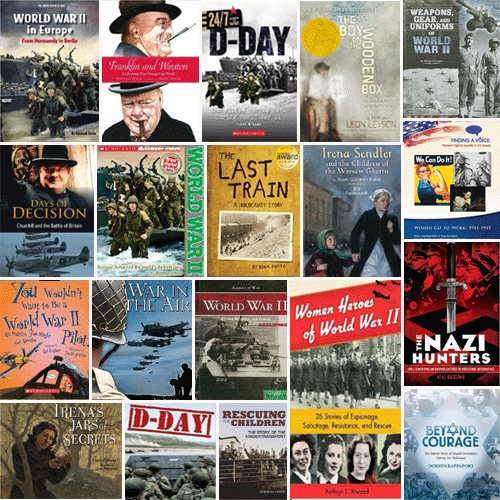
Reviews
|



